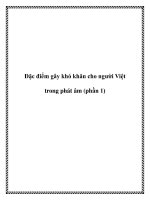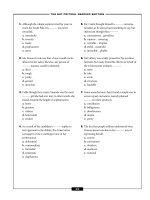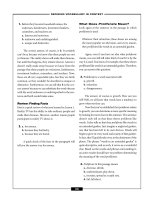reading skill 1 pot
Bạn đang xem bản rút gọn của tài liệu. Xem và tải ngay bản đầy đủ của tài liệu tại đây (61.91 KB, 6 trang )
189. Darwin’s explanation that the young of any
species compete for food and survival, and
those that survive are strong and pass their
traits on to their young was called which of
the following?
a. belief in creationism
b. the catastrophic theory
c. theory of natural selection and survival of
the fittest
d. the study of anthropology
190. According to the passage, how was Darwin’s
book, On the Origin of the Species,received?
a. Scientists gave their immediate approval of
Darwin’s book.
b. Religious opponents condemned Darwin’s
book.
c. The world ignored Darwin’s book.
d. Darwin’s book became an immediate
bestseller.
The crystal clear, blue water and the magnificent
sun make the Caribbean island of Saint Maarten
a favorite vacation spot, one that is popular with
North Americans during their winter holidays
from December through March, as well as with
South Americans and Europeans from April
through August. The French and Dutch settled
on the island in the 1600s, and to this day, the
island is divided between the two of them. The
French capital is Marigot; the Dutch capital is
Philipsburg.
Tourists soon discover that St. Maarten has
an intriguing history. Ancient artifacts found on
the island date back to the Stone Age, 6,000 years
ago! Tourists also learn that 1,200 years ago the
Arawak Indians inhabited all the islands of the
West Indies and were a peaceful people living
under the guidance of their chiefs. Three hundred
years after the Arawaks first arrived on St.
Maarten, in the 1300s, they were defeated and
forced to abandon the island by a hostile tribe of
Indians originating in South America. This new
tribe was called the Carib. The Caribbean Sea
was named after them. Unlike the Arawaks, they
had no permanent chiefs or leaders, except in
times of st
rife. And they were extremely warlike.
Worse, they were cannibalistic, eating the enemy
warriors they captured. In fact, the very word
cannibal comes from the Spanish name for the
Carib Indians. The Spanish arrived in the fif-
teenth century and, unfortunately, they carried
diseases to which the Indians had no immunity.
Many Indians succumbed to common European
illnesses; others died from the hard labor forced
upon them.
191. One can infer from the passage that the Stone
Age people lived on St. Maarten around the
year
a. 6000
B.C.
b. 4000
B.C.
c. 800
A.D.
d. 1300
A.D.
192. Which of the following is NOT true about the
Carib Indians?
a. The sea was named after them.
b. They were peaceful fishermen, hunters, and
farmers.
c. They ate human flesh.
d. They settled after defeating the Arawak
Indians.
193. According to the passage, the Carib Indians
were finally defeated by
a. sickness and forced labor.
b. the more aggressive Arawak tribe.
c. the Dutch West India Company.
d. the French explorers.
– SHORT PASSAGES–
40
194. One can infer from the passage that the
underlined word strife means
a. cannibalism.
b. war.
c. duty-free.
d. chief.
195. According to the article, present-day St.
Maarten
a. belongs to the Spanish.
b. is independent.
c. is shared by the French and the Dutch.
d. is part of the U.S. Virgin Islands.
A metaphor is a poetic device that deals with
comparison. It compares similar qualities of two
dissimilar objects. With a simple metaphor, one
object becomes the other: Love is a rose. Although
this does not sound like a particularly rich image,
a metaphor can communicate so much about a
particular image that poets use them more than
any other type of figurative language. The reason
for this is that poets compose their poetry to
express what they are experiencing emotionally
at that moment. Consequently, what the poet
imagines love to be may or may not be our per-
ception of love. Therefore, the poet’s job is to
enable us to experience it, to feel it the same way
that the poet does. We should be able to nod in
agreement and say, “Yes, that’s it! I understand
precisely where this person is coming from.”
Let’s analyze this remarkably unsophisti-
cated metaphor concerning love and the rose to
see what it offers. Because the poet uses a com-
parison with a rose, first we must examine the
characteristics of that flower. A rose is spectacu-
lar in its beauty, its petals are velvety soft, and its
aroma is soothing and pleasing. It’s possible to
say that a rose is actually a veritable feast to the
senses: the visual, the tactile, and the aural [more
commonly known as the senses of sight, touch,
and sound]. The rose’s appearance seems to bor-
der on perfection, each petal seemingly symmet-
rical in form. Isn’t this the way one’s love should
be? A loved one should be a delight to one’s
senses and seem perfect. However, there is
another dimension added to the comparison by
using a rose. Roses have thorns. This is the com-
prehensive image the poet wants to communi-
cate; otherwise, a daisy or a mum would have
been presented to the audience as the ultimate
representation of love—but the poet didn’t,
instead conveying the idea that roses can be
treacherous. So can love, the metaphor tells us.
When one reaches out with absolute trust to
touch the object of his or her affection, ouch, a
thorn can cause great harm! “Be careful,” the
metaphor admonishes: Love is a feast to the
senses, but it can overwhelm us, and it can also
hurt us. It can prick us and cause acute suffering.
This is the poet’s perception of love—an admo-
nition. What is the point? Just this: It took almost
14 sentences to clarify what a simple metaphor
communicates in only five words! That is the
artistry and the joy of the simple metaphor.
196. The main idea of this passage is
a. poetic devices are necessary for poets.
b. poetry must never cater to the senses.
c. always use words that create one
specific image.
d. the metaphor is a great poetic device.
197. It can be inferred that a metaphor is
a. a type of figurative language.
b. the only poetic device.
c. not precise enough.
d. a type of flower in a poem.
– SHORT PASSAGES–
41
198. According to the passage, thorns
a. protect the rose from harm.
b. reduce the ability to love another.
c. add a new element to the image of love.
d. are just more images to compare to a rose.
199. It can be inferred that the true meaning of the
love is a rose metaphor is that
a. love is a true joy.
b. love comes only once in a lifetime.
c. love is never permanent.
d. love is a combination of good and bad
experiences.
200. According to the passage, the poet’s
intention is
a. to release anger.
b. to announce heartache.
c. to enable you to experience the poet’s point
of view.
d. to reward the senses.
The composer Wolfgang Amadeus Mozart’s
remarkable musical talent was apparent even
before most children can sing a simple nursery
rhyme. Wolfgang’s older sister Maria Anna (who
the family called Nannerl) was learning the
clavier, an early keyboard instrument, when
her three-year-old brother took an interest in
playing. As Nannerl later recalled, Wolfgang
“often spent much time at the clavier picking out
thirds, which he was always striking, and his
pleasure showed that it sounded good.” Their
father Leopold, an assistant concertmaster at
the Salzburg Court, recognized his children’s
unique gifts and soon devoted himself to their
musical education.
Born in Salzburg, Austria, on January 27,
1756, Wolfgang had composed his first original
work by age five. Leopold planned to take Nan-
nerl and Wolfgang on tour to play before the
European courts. Their first venture was to
nearby Munich where the children played for
Maximillian III Joseph, elector of Bavaria.
Leopold soon set his sights on the capital of the
Hapsburg Empire, Vienna. On their way to
Vienna, the family stopped in Linz, where Wolf-
gang gave his first public concert. By this time,
Wolfgang was not only a virtuoso harpsichord
player, but he had also mastered the violin. The
audience at Linz was stunned by the six-year-old,
and word of his genius soon traveled to Vienna.
In a much anticipated concert, the Mozart chil-
dren appeared at the Schonbrunn Palace on
October 13, 1762. They utterly charmed the
emperor and empress.
Following this success, Leopold was inun-
dated with invitations for the children to play,
for a fee. Leopold seized the opportunity and
booked as many concerts as possible at courts
throughout Europe. A concert could last three
hours, and the children played at least two per a
day. Today, Leopold might be considered the
worst kind of stage parent, but at the time, it was
not uncommon for prodigies to make extensive
concert tours. Even so, it was an exhausting sched-
ule for a child who was just past the age of need-
ing an afternoon nap.
– SHORT PASSAGES–
42
201. A good title for this passage would be
a. Classical Music in the Eighteenth Century:
An Overview.
b. Stage Parents: A Historical Perspective.
c. Mozart: The Early Life of a Musical
Prodigy.
d. Mozart: The Short Career of a
Musical Genius.
202. According to the passage, Wolfgang became
interested in music because
a. his father thought it would be profitable.
b. he had a natural talent.
c. he saw his sister learning to play an
instrument.
d. he came from a musical family.
203. What was the consequence of Wolfgang’s first
public appearance?
a. He charmed the emperor and empress
of Hapsburg.
b. Word of Wolfgang’s genius spread to
the capital.
c. Leopold set his sights on Vienna.
d. Invitations for the miracle children to play
poured in.
204. Each of the following statements about Wolf-
gang Mozart is directly supported by the pas-
sage EXCEPT
a. Mozart’s father, Leopold, was instrumental
in shaping his career.
b. Maria Anna was a talented musician in her
own right.
c. Wolfgang’s childhood was devoted to his
musical career.
d. Wolfgang preferred the violin to other
instruments.
205. According to the passage, during Wolfgang’s
early years, child prodigies were
a. few and far between.
b. accustomed to extensive concert tours.
c. expected to spend at least six hours per a
day practicing their music.
d. expected to play for courts throughout
Europe.
206. Based on information found in the passage,
Mozart can best be described as
a. a child prodigy.
b. a workaholic.
c. the greatest composer of the eighteenth
century.
d. a victim of his father’s ambition.
– SHORT PASSAGES–
43
The sentences are numbered in the following passage
to help you answer the questions.
1) The Woodstock Music and Art Fair—better
known to its participants and to history simply as
“Woodstock”—should have been a colossal fail-
ure. 2) Just a month prior to its August 15, 1969
opening, the fair’s organizers were informed by
the council of Wallkill, New York, that permission
to hold the festival was withdrawn. 3) Amazingly,
not only was a new site found, but word spread to
the public of the fair’s new location. 4) At the
new site, fences that were supposed to facilitate
ticket collection never materialized, and all
attempts at gathering tickets were abandoned. 5)
Crowd estimates of 30,000 kept rising; by the end
of the three days, some estimated the crowd at
500,000. 6) Then, on opening night, it began to
rain. 7) Off and on, throughout all three days,
huge summer storms rolled over the gathering. 8)
In spite of these problems, most people think of
Woodstock not only as a fond memory but as
the defining moment for an entire generation.
207. Which of the following would be the most
appropriate title for this passage?
a. Backstage at Woodstock
b. Woodstock: From The Band to The Who
c. Remembering Woodstock
d. Woodstock: The Untold Story
208. Which of the following numbered sentences
of the passage best represents an opinion
rather than a fact?
a. sentence 1
b. sentence 2
c. sentence 3
d. sentence 4
209. Why is the word amazingly used in sentence 3?
a. The time in which the site move was made
and the word sent out was so short.
b. The fair drew such an unexpectedly enor-
mous crowd.
c. There was such pressure by New York offi-
cials against holding the fair.
d. The stormy weather was so unfavorable.
– SHORT PASSAGES–
44
I
n this section, you will be dealing with nonfiction and information passages, such as the type you might
find in a textbook. Mastering these types of passages and their questions is important, because they are
increasingly being found in standardized tests. These passages are not necessarily more difficult than the
ones you’ve already covered in the earlier chapters of this book. However, they do call more heavily for the spe-
cial skill of making inferences, of identifying implicit, as opposed to explicit, ideas stated in the text.
Remember what you’ve learned so far. Look at structure. Look for the main idea of the passage. Consider
the purpose for which the passage was written. What clues can you deduce from the writing style about the
author’s attitude toward the subject? Is the attitude positive? Negative? Objective? Try to pick out individual
words that further each writer’s intent and support each writer’s opinion. If it helps, underline or make notes
on important points. Active reading techniques like these will keep you focused on some very detailed reading
comprehension passages.
SECTION
Nonfiction and
Information
Passages
6
45
SECTION









